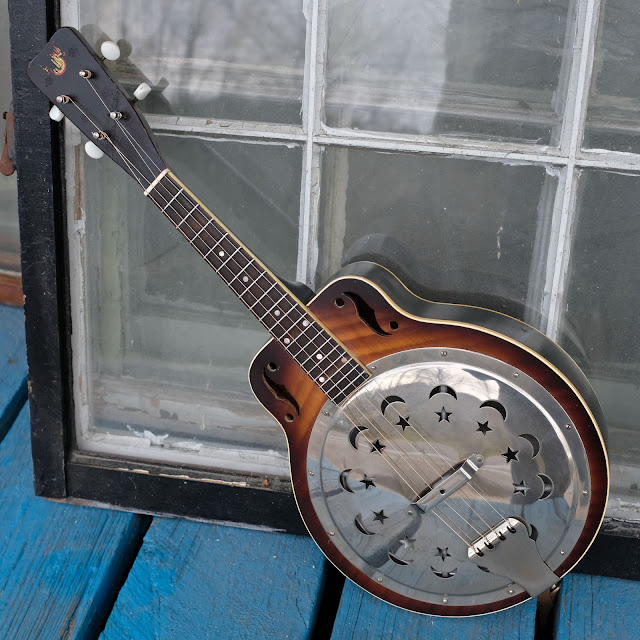1930s Dobro Resonator Mandolin (4-String Ukulele Setup)
Really cool, right? The sad story of this Dobro (Regal-made body) resonator mandolin is that its headstock was broken (who'd-a-thought that thin poplar with a stupid angle on it would split?) and has now been repaired twice. Unfortunately, serious coinage was lost the first time around by way of a very pretty routed-out channel and ebony (or carbon-fiber?) plug install.
When the owner brought it here, I advised gluing it up, reinforcing it a minor amount, and converting it into a 4-string instrument instead. He and his lady danced around a ukulele tuning and settled on a low-G setup. I knew that nylon/fluorocarbon would sound lousy on a mandolin cone, so we went with steel. So -- now it's essentially a 4-string mandolin but setup in uke tuning.
Work included resetting the neck (easy as it's shim-adjustable inside with a dowel), securing the neck joint a little more firmly (strap button hiding a bolt into the dowel from the back of the instrument), a fret level/dress, repair of the quite-damaged headstock split, new ebony saddles with proper compensation, a lot of massaging of the cone's outer-lip shape to get the bridge into a good position for intonation purposes, cleaning, and a setup. I threw in some parts-bin tuners on the house, but perhaps the owner will upgrade later-on. They work fine, though.
It plays spot-on with 1/16" action at the 12th fret, plays in tune, and has string gauges 36w, 26w, 20w, 15 for G, C, E, A tuning low-to-high. The neck is straight, I added side dots, and there's plenty of fret-life remaining. The sound is distinctly mids-focused "Dobro" in nature, with a lot of sweetened highs and a slightly nasal bark. It has good volume, too.
Specs are: 13 7/8" scale, 1 3/16" nut width, 7/8" string spacing at the nut, 1 5/8" spacing at the bridge, 8 1/2" resonator cone with original lightweight spider-bridge, 11" body width, and 2 1/2" depth.
Materials are: poplar neck, ebonized-maple fretboard, ply-birch body, maple neck dowel, celluloid binding, original cone, bridge, and moon/stars coverplate, pearl dots in the fretboard, and replacement ebony saddles.
I quickly patched the old tuner holes I wasn't using. The split in the headstock was not reglued seamlessly, either. This is due to its having been left a long time with the string tension still on it a bit, so parts were crumpled pretty bad. I managed to gloss over it a bit, though.
The nut is the original bone, though I sanded it done a little and jacked it up just a hair so I could reslot it for 4-string use.














Comments